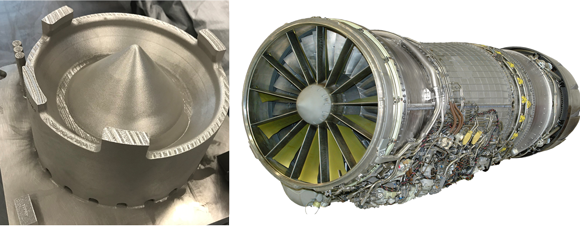GE gains US Air Force airworthiness qualification for first critical jet engine AM part
June 9, 2021

GE Aviation has received Engineering Change Proposal (ECP) approval from the US Air Force (USAF) for an additively manufactured sump cover used in the company’s F110 jet engine. The component is said to be the first engine part designed for and produced by metal Additive Manufacturing to be qualified by any US Department of Defense entity. The full approval process was concluded in under a year and represents the latest milestone in the USAF and GE’s pathfinder Pacer Edge programme.
“Much like the GE90 T25 sensor that was an FAA certification pathfinder for metal Additive Manufacturing for GE Aviation in commercial aerospace, the F110 sump cover sets a solid foundation for many more additively manufactured component qualifications with GE’s military customers,” stated Matt Szolwinski, Chief Engineer and leader of GE’s Large Military Engineering team.
The airworthiness qualification of the sump cover brings Pacer Edge Phase 1a of the pathfinder to its conclusion, with GE citing the key to the accelerated qualification being its decade of metal additive engineering and manufacturing expertise. The team’s in-depth knowledge of commercial aerospace engine airworthiness for flightworthy metal AM parts is seen as being instrumental in helping USAF establish its own robust process validation and certification processes for military airworthiness.
“The Pacer Edge programme is an important initiative for reducing risk and showcasing the application of Additive Manufacturing in aerospace. The ability to additively manufacture an aircraft engine part and gain military airworthiness is a significant step forward in growing the adoption of additive manufacturing in the Air Force,” added Nathan Parker, Deputy Program Executive Officer for the USAF RSO.

“The Chief of Staff of the Air Force, General Charles Q Brown, Jr, has challenged us to ‘accelerate change or lose.’ The entire Pacer Edge process is built around the ‘accelerate change’ philosophy, and the speed of the F110 sump cover development and airworthiness approval is evidence of that. The capability that Pacer Edge is demonstrating and proving will be a game-changer to engine production and sustainment and will resolve many future Air Force readiness challenges,” commented John Sneden, director of the USAF’s Directorate of Propulsion.
Close collaboration and knowledge sharing have reportedly enhanced USAF’s spiral development approach of continuously identifying, reverse engineering and developing technical data packages (TDPs) for increasingly complex and larger parts suitable for metal Additive Manufacturing.
“USAF’s strong vision for additive as part of its wider sustainment and readiness strategy has allowed our combined team to progress at speed. We continue to share our learnings and have developed an efficient, structured way of working – especially for developing qualification processes and expediting design iterations. This lean, operational efficiency is already driving results and now sets us up for the next phases of the program, including looking at complex and large format, load-carrying structures,” said Szolwinski.
Phase 1b is already underway and focuses on an out-of-production sump cover housing on the TF34 engine, which has been in service for over forty years.
“We’re thrilled to be on this journey with USAF. Additive journeys are great, but even better when you have a good map and experienced guides. We started with a relatively easy part, but the spiral development model is coming into its own. It provides focus for the team and our experts help navigate and problem solve along the way,” stated Lisa Coroa-Bockley, General Manager for GE’s Advanced Materials Solutions.
A digital thread also runs through the pathfinder. GE experts focused on digital twinning, maintenance-based predictive analytics and part lifecycle management expertise have been able to complement the USAF’s digital engineering strategy and in-house knowledge.
“Human interaction and collaboration both add immense value to our work, but digital is the enabler. Additive is a powerful digital technology that spans the entire process, from design and modelling, to in-situ monitoring through to inspection and final level assurances,” added Coroa-Bockley. “Adding digital twinning and predictive analytics on top brings new horizons into view, such as systems management, diagnostics and repair of in-field systems.”
“Subsequent phases of the Pacer Edge program involves the establishment of a metal Additive Manufacturing supply chain at Tinker Air Force Base in Oklahoma, capable of producing airworthy components in support of the DoD’s sustainment needs,” said Lauren Tubesing, Director – Military Accounts at GE Additive.
Recently, the Air Force’s Propulsion Directorate and RSO invested $10 million to fund additional phases of the Pacer Edge program, leveraging the Defense Logistics Agency’s (DLA) Captains of Industry contract vehicle. This funding will accelerate the development of the USAF’s organic AM capability and capacity to design and print flightworthy hardware for military engines, aircraft and support equipment. The Pacer Edge team is utilising this capability to alleviate hard-to-source and obsolete spare parts constraints for legacy systems.
“The F110 sump cover was a terrific pathfinder, allowing us to exercise the USAF’s airworthiness process. There are numerous parts in queue that are ideal candidates for metal 3D printing. Next, we are focused on refining the airworthiness process, so it is as responsive as the technology,” concluded Melanie Jonason, Chief Engineer for the USAF’s Propulsion Sustainment Division.
















